Yield Estimates by a Two-Step Approach Using Hyperspectral Methods in Grasslands at High Latitudes
Abstract
1. Introduction
2. Materials and Methods
2.1. Site Description
2.2. Spectra Acquisition
2.3. Reference Yield Measurements
2.4. Hyperspectral Analyses and Modelling
2.5. Satellite Simulation
2.6. Model Validation
2.7. Two-Stage Workflow
3. Results
3.1. Hyperspectral Analyses
3.2. Satellite Simulations
4. Discussion
5. Conclusions
Supplementary Materials
Author Contributions
Funding
Conflicts of Interest
References
- Courault, D.; Demarez, V.; Guérif, M.; Le Page, M.; Simonneaux, V.; Ferrant, S.; Veloso, A. Contribution of Remote Sensing for Crop and Water Monitoring. In Land Surface Remote Sensing in Agriculture and Forest; Elsevier: London, UK, 2016; pp. 113–177. ISBN 9781785481031. [Google Scholar]
- Peñuelas, J.; Filella, I.; Biel, C.; Serrano, L.; Save, R. The reflectance at the 950-970 nm region as an indicator of plant water status. Int. J. Remote Sens. 1993, 14, 1887–1905. [Google Scholar] [CrossRef]
- Alvarez-Taboada, F.; Paredes, C.; Julián-Pelaz, J. Mapping of the invasive species Hakea sericea using Unmanned Aerial Vehicle (UAV) and worldview-2 imagery and an object-oriented approach. Remote Sens. 2017, 9, 913. [Google Scholar] [CrossRef]
- Moran, M.S.; Inoue, Y.; Barnes, E.M. Opportunities and limitations for image-based remote sensing in precision crop management. Remote Sens. Environ. 1997, 61, 319–346. [Google Scholar] [CrossRef]
- Bannari, A.; Morin, D.; Bonn, F.; Huete, A.R. A review of vegetation indices. Remote Sens. Rev. 1995, 13, 95–120. [Google Scholar] [CrossRef]
- Zagajewski, B.; Tømmervik, H.; Bjerke, J.W.; Raczko, E.; Bochenek, Z.; Klos, A.; Jarocińska, A.; Lavender, S.; Ziólkowski, D. Intraspecific differences in spectral reflectance curves as indicators of reduced vitality in high-arctic plants. Remote Sens. 2017, 9, 1289. [Google Scholar] [CrossRef]
- Kokaly, R.F.; Clark, R.N. Spectroscopic determination of leaf biochemistry using band-depht analysis of absorption features and stepwise multiple linear regression. Remote Sens. Environ. 1999, 67, 267–287. [Google Scholar] [CrossRef]
- Martens, H.; Næs, T. Multivariate Calibration; Wiley: Chichester, UK, 1989; ISBN 0471930474. [Google Scholar]
- Lu, D.; Weng, Q. A survey of image classification methods and techniques for improving classification performance. Int. J. Remote Sens. 2016, 28, 823–870. [Google Scholar] [CrossRef]
- Cramer, R.D.; Bounce, J.D.; Patterson, D.E.; Frnak, I.E. Crossvalidation, bootstrapping, and partial least squares compared with multiple regression in comventional QSAR studies. Quant. Struct. relationships 1988, 7, 18–25. [Google Scholar] [CrossRef]
- Doraiswamy, P.C.; Moulin, S.; Cook, P.W.; Stern, A. Crop yield assessment from remote sensing. Photogramm. Eng. Remote Sens. 2003, 69, 665–674. [Google Scholar] [CrossRef]
- Biewer, S.; Erasmi, S.; Fricke, T.; Wachendorf, M. Prediction of yield and the contribution of legumes in legume-grass mixtures using field spectrometry. Precis. Agric. 2009, 10, 128–144. [Google Scholar] [CrossRef]
- Fu, Y.; Yang, G.; Wang, J.; Song, X.; Feng, H. Winter wheat biomass estimation based on spectral indices, band depth analysis and partial least squares regression using hyperspectral measurements. Comput. Electron. Agric. 2014, 100, 51–59. [Google Scholar] [CrossRef]
- Singla, S.K.; Garg, R.D.; Dubey, O.P. Spatiotemporal analysis of Landsat Data for crop yield prediction. J. Eng. Sci. Technol. Rev. 2018, 11, 9–17. [Google Scholar] [CrossRef]
- Chen, P.; Jing, Q. A comparison of two adaptive multivariate analysis methods (PLSR and ANN) for winter wheat yield forecasting using Landsat-8 OLI images. Adv. Sp. Res. 2017, 59, 987–995. [Google Scholar] [CrossRef]
- Gao, F.; He, T.; Masek, J.G.; Shuai, Y.; Schaaf, C.B.; Wang, Z. Angular effects and correction for medium resolution sensors to support crop monitoring. IEEE J. Sel. Top. Appl. Earth Obs. Remote Sens. 2014, 7, 4480–4489. [Google Scholar] [CrossRef]
- Bishop, J.K.B.; Rossow, W. Spatial and temporal variability of global surface solar irradiance. J. Geophys. Res. 1991, 96858, 16839–16858. [Google Scholar] [CrossRef]
- Seemann, S.W.; Borbas, E.E.; Knuteson, R.O.; Stephenson, G.R.; Huang, H.L. Development of a global infrared land surface emissivity database for application to clear sky sounding retrievals from multispectral satellite radiance measurements. J. Appl. Meteorol. Climatol. 2008, 47, 108–123. [Google Scholar] [CrossRef]
- Whitlock, C.H.; Bartlett, D.S.; Gurganus, E.A. Sea foam reflectance and influence on optimum wavelength for remote sensing of ocean aerosols. Geophys. Res. Lett. 1982, 9, 719–722. [Google Scholar] [CrossRef]
- Young, N.E.; Anderson, R.S.; Chignell, S.M.; Vorster, A.G.; Lawrence, R.; Evangelista, P.H. A survival guide to Landsat preprocessing. Ecology 2017, 98, 920–932. [Google Scholar] [CrossRef]
- USGS Landsat Surface Level Reflectance Products. Available online: https://landsat.usgs.gov/landsat-surface-reflectance-data-products (accessed on 29 January 2019).
- Beck, P.S.A.; Atzberger, C.; Høgda, K.A.; Johansen, B.; Skidmore, A.K. Improved monitoring of vegetation dynamics at very high latitudes: A new method using MODIS NDVI. Remote Sens. Environ. 2006, 100, 321–334. [Google Scholar] [CrossRef]
- Sibanda, M.; Mutanga, O.; Rouget, M. Comparing the spectral settings of the new generation broad and narrow band sensors in estimating biomass of native grasses grown under different management practices. GIScience Remote Sens. 2016, 53, 614–633. [Google Scholar] [CrossRef]
- Foerster, S.; Carrère, V.; Rast, M.; Staenz, K. Preface: The environmental mapping and analysis program (EnMAP) mission: Preparing for Its scientific exploitation. Remote Sens. 2016, 8, 957. [Google Scholar] [CrossRef]
- European Space Agency Sentinel-2 Information Website. Available online: https://earth.esa.int/web/guest/missions/esa-operational-eo-missions/sentinel-2 (accessed on 29 January 2019).
- Han, J.; Wei, C.; Chen, Y.; Liu, W.; Song, P.; Zhang, D.; Wang, A.; Song, X.; Wang, X.; Huang, J. Mapping above-ground biomass ofwinter oilseed rape using high spatial resolution satellite data at parcel scale under waterlogging conditions. Remote Sens. 2017, 9, 238. [Google Scholar] [CrossRef]
- Sakowska, K.; Juszczak, R.; Gianelle, D. Remote Sensing of Grassland Biophysical Parameters in the Context of the Sentinel-2 Satellite Mission. J. Sensors 2016, 2016. [Google Scholar] [CrossRef]
- Skakun, S.; Franch, B.; Vermote, E.; Roger, J.-C.; Justice, C.; Masek, J.; Murphy, E. Winter wheat yield assessment using Landsat 8 and Sentinel-2 data. IGARSS 2018 - 2018 IEEE Int. Geosci. Remote Sens. Symp. 2018, 5964–5967. [Google Scholar] [CrossRef]
- Lu, D. The potential and challenge of remote sensing-based biomass estimation. Int. J. Remote Sens. 2006, 27, 1297–1328. [Google Scholar] [CrossRef]
- Bausch, W.C.; Duke, H.R. Remote sensing of plant nitrogen status in corn. Trans. ASAE 1996, 39, 1869–1875. [Google Scholar] [CrossRef]
- Tilling, A.K.; O’Leary, G.J.; Ferwerda, J.G.; Jones, S.D.; Fitzgerald, G.J.; Rodriguez, D.; Belford, R. Remote sensing of nitrogen and water stress in wheat. F. Crop. Res. 2007, 104, 77–85. [Google Scholar] [CrossRef]
- Punalekar, S.M.; Verhoef, A.; Quaife, T.L.; Humphries, D.; Bermingham, L.; Reynolds, C.K. Application of Sentinel-2A data for pasture biomass monitoring using a physically based radiative transfer model. Remote Sens. Environ. 2018, 218, 207–220. [Google Scholar] [CrossRef]
- Locherer, M. Capacity of the Hyperspectral Satellite Mission EnMAP for the Multiseasonal Monitoring of Biophysical and Biochemical Land Surface Parameters in Agriculture by Transferring an Analysis Method for Airborne Image Spectroscopy to the Spaceborne Scale, Ludwig Maximilian University of Munich, Munich. 4 November 2014. [Google Scholar]
- Ahmad, I.S.; Reid, J.F.; Noguchi, N.; Hansen, A.C. Nitrogen sensing for precision agriculture using chlorophyll maps. In Proceedings of the 1999 ASAE/CSAE-SCGR Annual International Meeting, Toronto, ON, Canada, 1999. [Google Scholar]
- Geipel, J.; Korsaeth, A. Hyperspectral Aerial Imaging for Grassland Yield Estimation. Adv. Anim. Biosci. 2017, 8, 770–775. [Google Scholar] [CrossRef]
- Bongiovanni, R.; Lowenberg-Deboer, J. Precision agriculture and sustainability. Precis. Agric. 2004, 5, 359–387. [Google Scholar] [CrossRef]
- Adesogan, A.; Givens, D.I.; Owen, E. Measuring Chemical Compounds and Nutritive Value in Forages. In Field and Laboratory Methods for Grassland and Animal Production; T’Mannetje, L., Jones, R.M., Eds.; CABI Publishing: Oxon, UK, 2000; pp. 263–278. [Google Scholar]
- R Core Team, R. Available online: https://www.R-project.org/ (accessed on 29 January 2019).
- Rinnan, Å.; Van Den Berg, F.; Engelsen, S.B. Review of the most common pre-processing techniques for near-infrared spectra. TrAC Trends Anal. Chem. 2009, 28, 1201–1222. [Google Scholar] [CrossRef]
- Savitzky, A.; Golay, M.J.E. Smoothing and differentiation of data by simplified least squares procedures. Anal. Chem. 1964, 36, 1627–1639. [Google Scholar] [CrossRef]
- Geladi, P.; Kowalski, B.R. Partial least-squares regression: A tutorial. Anal. Chim. Acta 1986, 185, 1–17. [Google Scholar] [CrossRef]
- Mevik, B.-H.; Wehrens, R. The pls package: Principal component and partial least squares regression in R. J. Stat. Softw. 2007, 18, 1–24. [Google Scholar] [CrossRef]
- European Space Agency Sentinel-2 Radiometric Resolutions. Available online: https://sentinel.esa.int/web/sentinel/user-guides/sentinel-2-msi/resolutions/radiometric (accessed on 29 January 2019).
- Stevens, A.; Ramirez–Lopez, L. An Introduction to the Prospectr Package. R package Vignette version 0.1.3. 2014. Available online: https://cran.r-project.org/web/packages/prospectr/index.html (accessed on 29 January 2019).
- Barmeier, G.; Hofer, K.; Schmidhalter, U. Mid-season prediction of grain yield and protein content of spring barley cultivars using high-throughput spectral sensing. Eur. J. Agron. 2017, 90, 108–116. [Google Scholar] [CrossRef]
- Øvergaard, S.I.; Isaksson, T.; Kvaal, K.; Korsaeth, A. Comparisons of Two Hand-Held, Multispectral Field Radiometers and a Hyperspectral Airborne Imager in Terms of Predicting Spring Wheat Grain Yield and Quality by Means of Powered Partial Least Squares Regression. J. Near Infrared Spectrosc. 2010, 18, 247–261. [Google Scholar] [CrossRef]
- Prasad, A.K.; Chai, L.; Singh, R.P.; Kafatos, M. Crop yield estimation model for Iowa using remote sensing and surface parameters. Int. J. Appl. Earth Obs. Geoinf. 2006, 8, 26–33. [Google Scholar] [CrossRef]
- Hansen, P.M.; Schjoerring, J.K. Reflectance measurement of canopy biomass and nitrogen status in wheat crops using normalized difference vegetation indices and partial least squares regression. Remote Sens. Environ. 2003, 86, 542–553. [Google Scholar] [CrossRef]
- Hadoux, X.; Gorretta, N.; Roger, J.M.; Bendoula, R.; Rabatel, G. Comparison of the efficacy of spectral pre-treatments for wheat and weed discrimination in outdoor conditions. Comput. Electron. Agric. 2014, 108, 242–249. [Google Scholar] [CrossRef]
- Sibanda, M.; Mutanga, O.; Rouget, M. Examining the potential of Sentinel-2 MSI spectral resolution in quantifying above ground biomass across different fertilizer treatments. ISPRS J. Photogramm. Remote Sens. 2015, 110, 55–65. [Google Scholar] [CrossRef]
- Siegmann, B.; Jarmer, T.; Beyer, F.; Ehlers, M. The potential of pan-sharpened EnMAP data for the assessment of wheat LAI. Remote Sens. 2015, 7, 12737–12762. [Google Scholar] [CrossRef]
- Gerighausen, H.; Lilienthal, H.; Jarmer, T.; Siegmann, B. Evaluation of Leaf Area Index and Dry Matter Predictions for Crop Growth Modelling and Yield Estimation. EARSeL eProceedings 2015, 71–90. [Google Scholar] [CrossRef]
- Guanter, L.; Kaufmann, H.; Segl, K.; Foerster, S.; Rogass, C.; Chabrillat, S.; Kuester, T.; Hollstein, A.; Rossner, G.; Chlebek, C.; et al. The EnMAP spaceborne imaging spectroscopy mission for earth observation. Remote Sens. 2015, 7, 8830–8857. [Google Scholar] [CrossRef]
- Owens, L.B.; Shipitalo, M.J. Surface and Subsurface Phosphorus Losses from Fertilized Pasture Systems in Ohio. J. Environ. Qual. 2006, 35, 1101. [Google Scholar] [CrossRef] [PubMed]
- Brar, B.; Singh, J.; Singh, G.; Kaur, G. Effects of Long Term Application of Inorganic and Organic Fertilizers on Soil Organic Carbon and Physical Properties in Maize–Wheat Rotation. Agronomy 2015, 5, 220–238. [Google Scholar] [CrossRef]
- Geisseler, D.; Scow, K.M. Long-term effects of mineral fertilizers on soil microorganisms—A review. Soil Biol. Biochem. 2014, 75, 54–63. [Google Scholar] [CrossRef]
- Nichols, V.; Verhulst, N.; Cox, R.; Govaerts, B. Weed dynamics and conservation agriculture principles: A review. F. Crop. Res. 2015, 183, 56–68. [Google Scholar] [CrossRef]
- Bajwa, A.A. Sustainable weed management in conservation agriculture. Crop Prot. 2014, 65, 105–113. [Google Scholar] [CrossRef]
- Peralta, N.R.; Costa, J.L.; Balzarini, M.; Castro Franco, M.; Córdoba, M.; Bullock, D. Delineation of management zones to improve nitrogen management of wheat. Comput. Electron. Agric. 2015, 110, 103–113. [Google Scholar] [CrossRef]
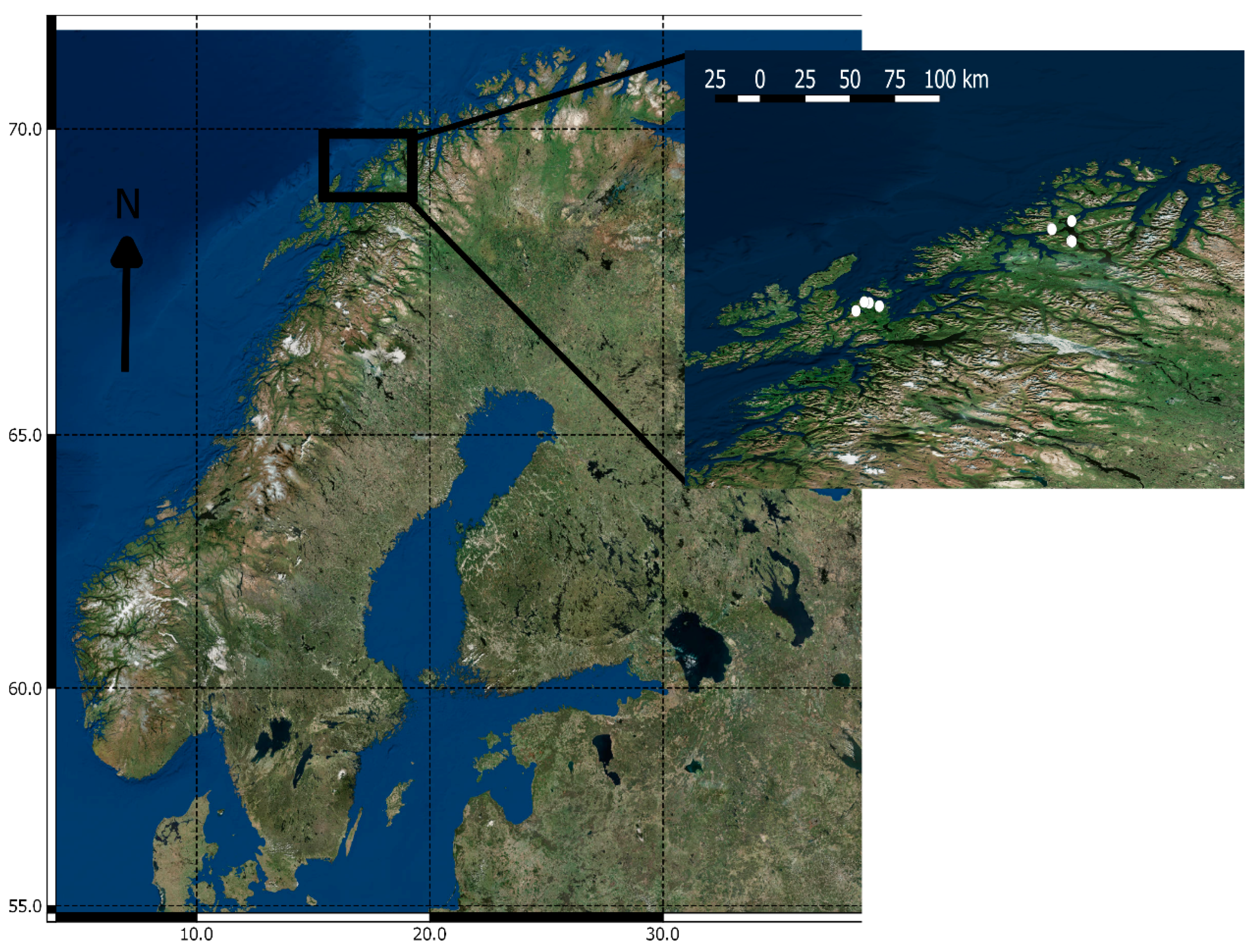
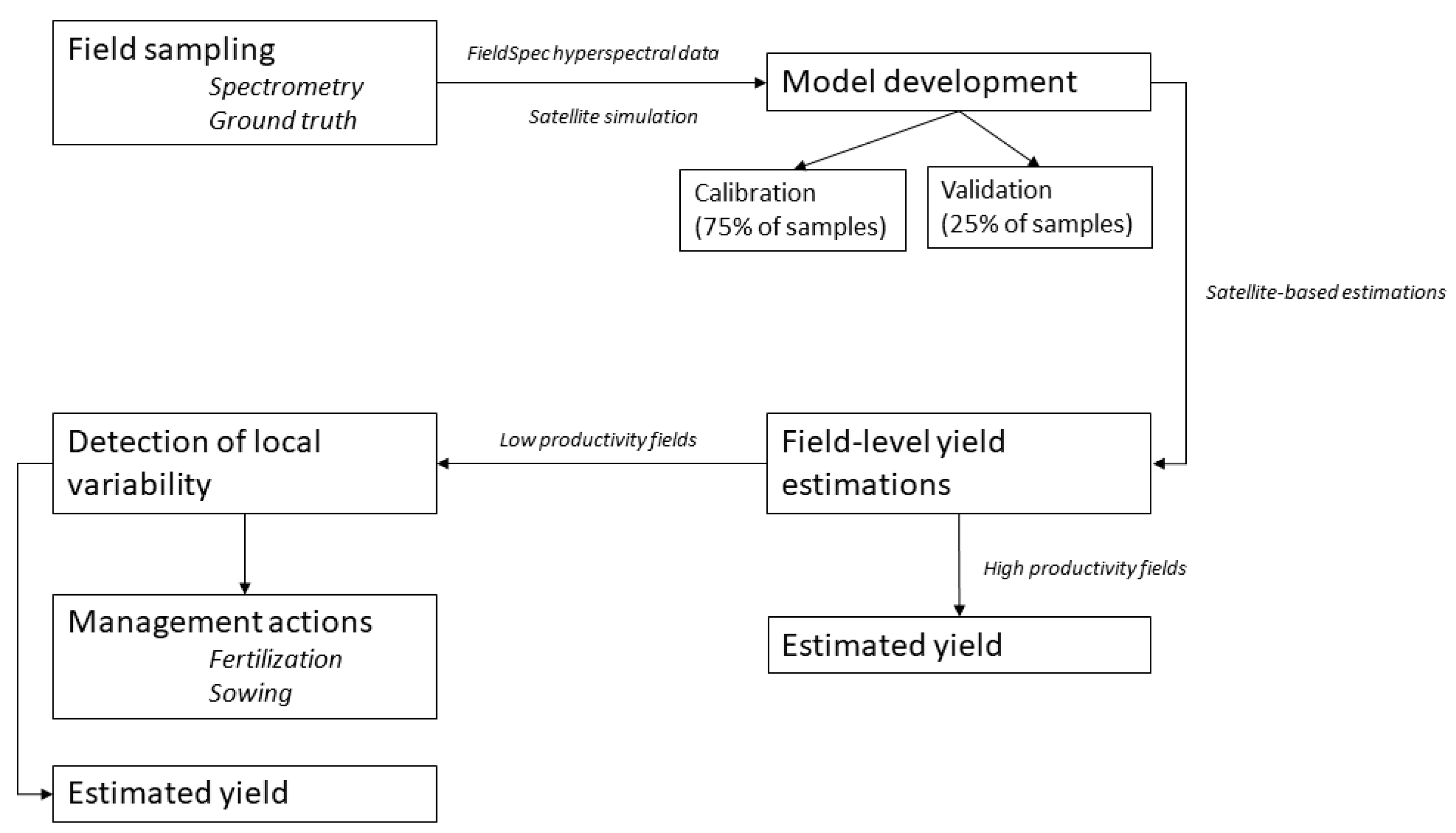
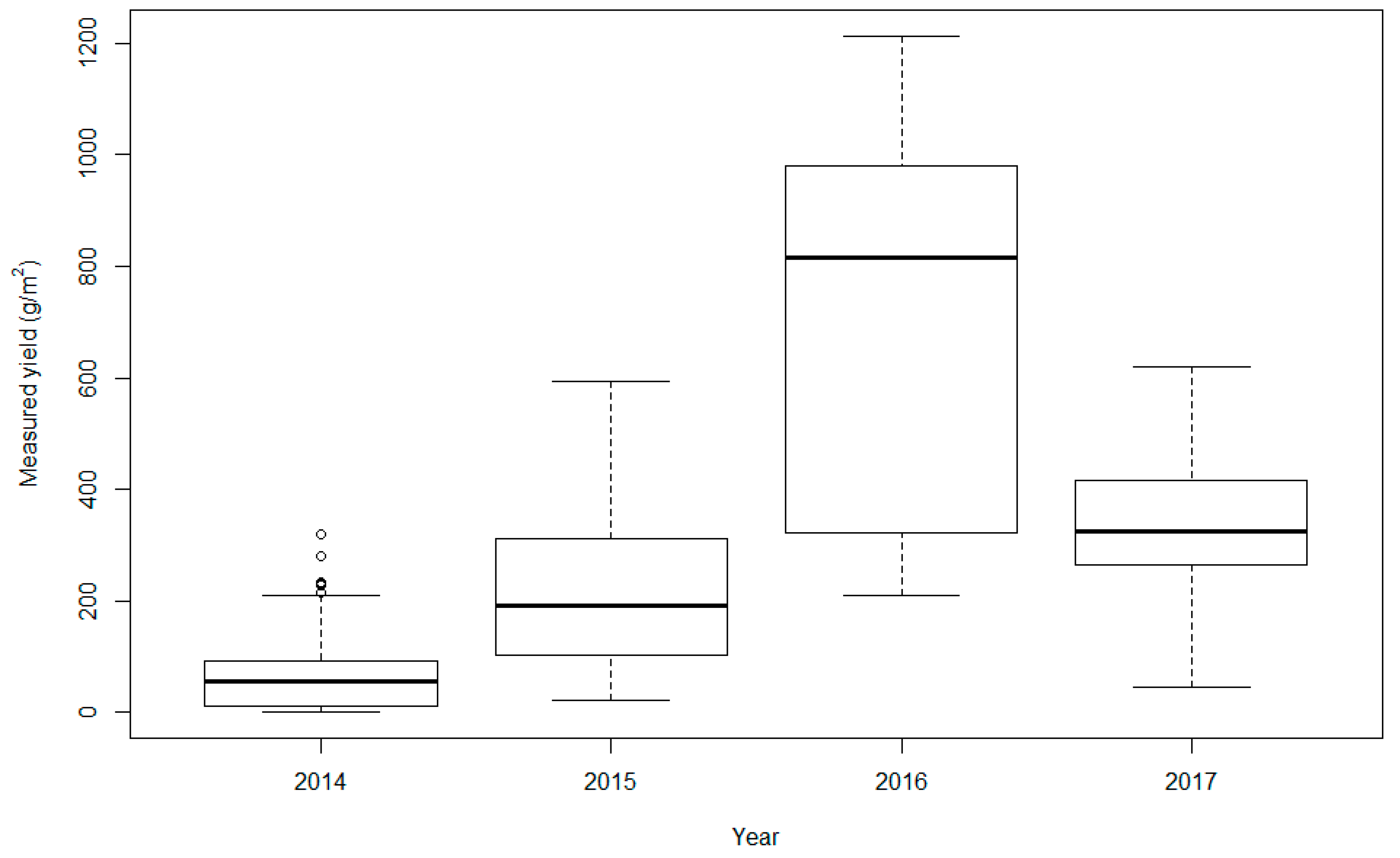
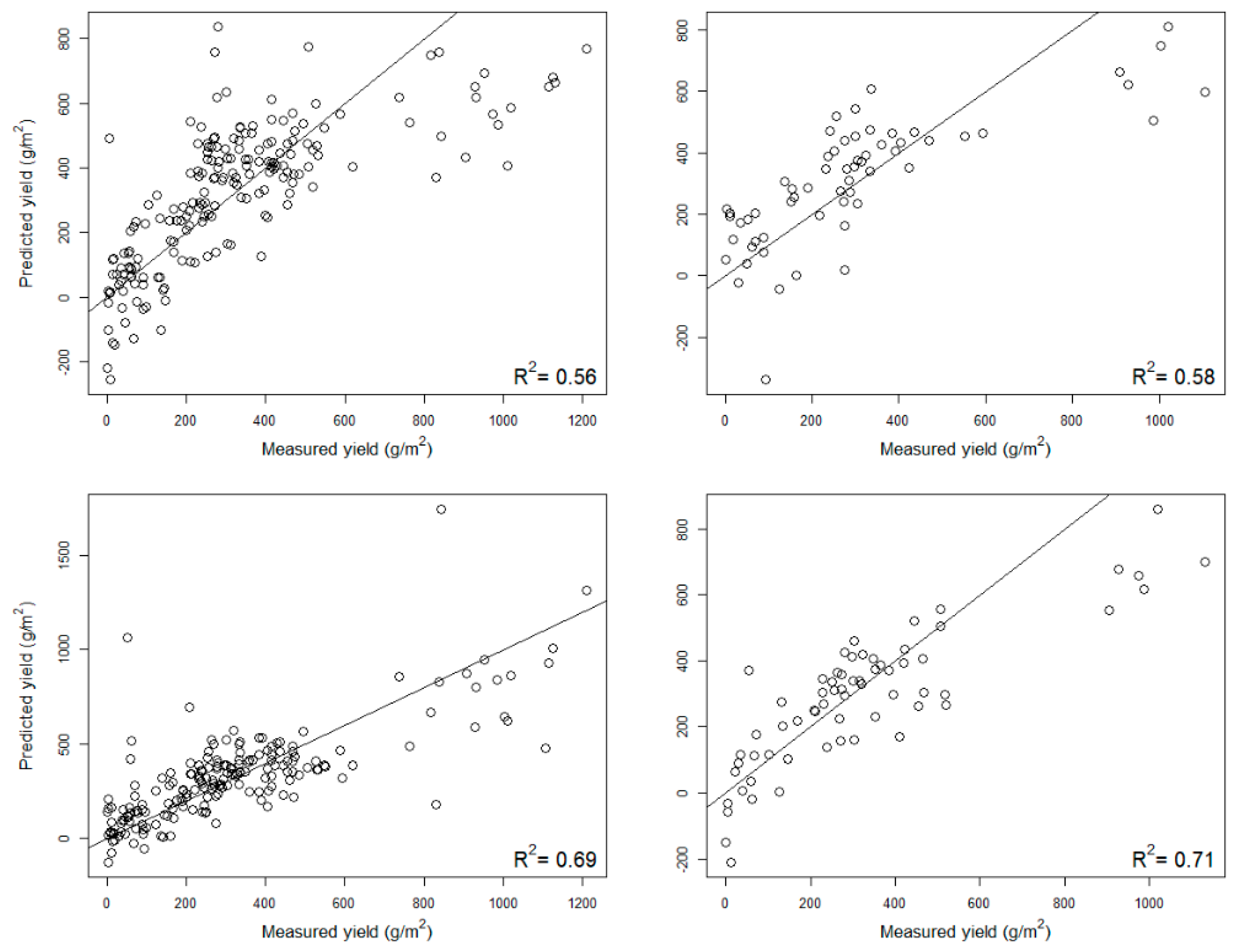
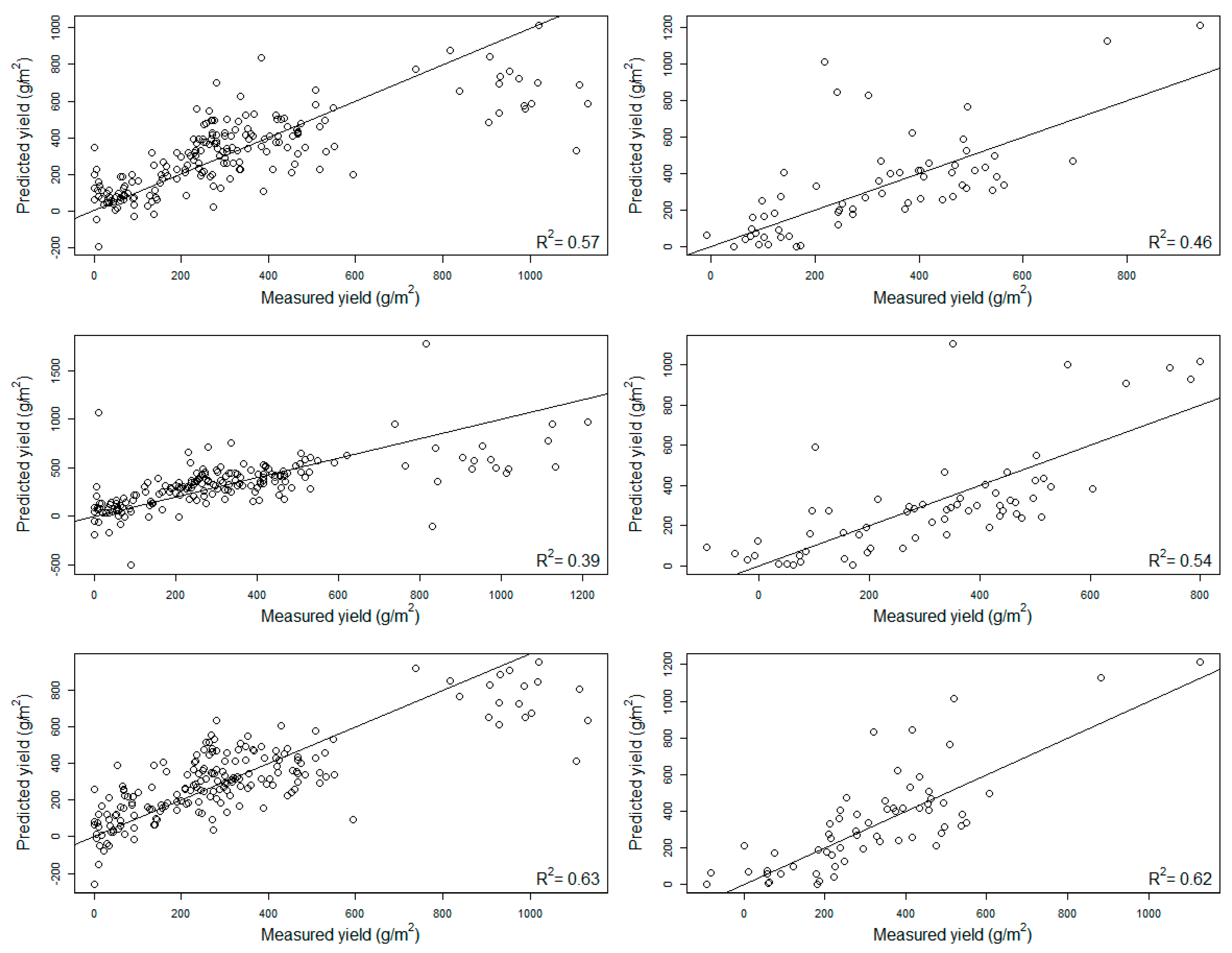
| Year | Region | Grass Field | Latitude Longitude | m.a.s.l. | Field Size, ha | Botanical Composition | Years Since Establish. | Date of Acquisition (D) and No. of Yield and ASD FieldSpec3 Measurements (n) | ||
|---|---|---|---|---|---|---|---|---|---|---|
| 2014 | Tromsø | T1 | 69°34′37″N 18°39′11″E | 29 | 1.51 | Phleum pratense 56%, Agrostis capillaris 26%, Ranunculus repens 10%, Alopecurus geniculatus 3%, Poa pratensis 3% | 2 | D = 7. Jun n = 6 | D = 23. Jun n = 6 | D = 8. Jul n = 6 |
| T2 | 69°34′33″N 18°39′09″E | 27 | 0.97 | P. pratense 45%, R. repens 33%, A. capillaris 8%, P. pratensis 2% | 2 | D = 7. Jun n = 6 | D = 23. Jun n = 6 | D = 8. Jul n = 6 | ||
| T3 | 69°39′05″N 18°54′13″E | 10 | 1.42 | A. capillaris 46%, A. geniculatus 18%, R. repens 13%, P. pratense 9%, Trifolium repens 5% | 10 | D = 6. June n = 6 | D = 24. Jun n = 6 | D = 7. Jul n = 6 | ||
| 2015 | Tromsø | T1 | 69°34′37″N 18°39′11″E | 29 | 1.51 | P. pratense 42%, R. repens 22%, A. capillaris 21%, A. geniculatus 7%, Deschampsia cespitosa 6%, P. pratensis 2% | 3 | D = 18. Jun n = 6 | D = 30. Jun n = 6 | D = 13. Jul n = 6 |
| T2 | 69°34′33″N 18°39′09″E | 27 | 0.97 | R. repens 39%, P. pratense 36%, A. capillaris 12%, D. cespitosa 8%, A. geniculatus 5% | 3 | D = 18. Jun n = 6 | D = 30. Jun n = 6 | D = 13. Jul n = 6 | ||
| T4 | 69°34′12″N 18°39′32″E | 21 | 2.50 | P. pratense 59%, P. pratensis 24%, Rumex crispus 5%, A. capillaris 5%, Taraxum officinale 3%, R. repens 3% | 2 | D = 19. Jun n = 6 | D = 26. Jun n = 6 | D = 9. Jul n = 6 | ||
| 2016 | Harstad | H1 | 68°47′43″N 16°27′46″E | 105 | 2.18 | P. pratense 70%, Festuca pratensis 11%, Trifolium pratense 7%, weeds 12% | 2 | D = 26. Jun n = 12 | ||
| H2 | 68°49′44″N 16°19′59″E | 32 | 1.55 | P. pratense 70%, F. pratensis 30% | 2 | D = 26. Jun n = 12 | ||||
| H3 | 68°50′12″N 16°16′8″E | 157 | 4.61 | P. pratense 75%, F. pratensis 25% | 2 | D = 26. Jun n = 7 | ||||
| H4 | 68°44′53″N 16°09′51″E | 23 | 2.9 | P. pratense 83%, F. pratensis 17% | 5 | D = 26. Jun n = 12 | ||||
| 2017 | Tromsø | MA1 | 69°27′18″N 18°54′11″E | 20 | 1.05 | P. pratensis 48%, P. pratense 32%, F. pratensis 8%, Elytrigia repens 8% Poa annua 2%, R. repens 2% | 4 | D = 06. Jul n = 27 | ||
| MA2 | 69°27′10″N 18°54′2″E | 37 | 0.95 | A. capillaris 36%, P. pratense 25%, P. pratensis 18%, F. pratensis 9%, D. cespitosa 6%, E. repens 4%, Rumex longifolius 1%, R. repens 1% | 5 | D = 06. Jul n = 23 | ||||
| MA3 | 69°26′48″N 18°54′55″E | 7 | 1.25 | P. pratense 48%, F. pratensis 27%, E. repens 14%, P. pratensis 3%, P. annua 3%, D. cespitosa 2%, R. repens 2%, A. capillaris 1% | 5 | D = 06. Jul n = 29 | ||||
| MA4 | 69°26′51″N 18°54′52″E | 7 | 0.9 | E. repens 44%, P. pratense 36%, P. pratensis 8%, P. annua 5%, Stellaria media 4%, F. pratensis 3%, | 7 | D = 06. Jul n = 24 | ||||
| k | Data Pre-Processing | R2 calibration | RMSECV (g/m2) | R2 validation | RMSEP (g/m2) | Intercept | Slope | Outliers | |
|---|---|---|---|---|---|---|---|---|---|
| Full range | |||||||||
| Good weather model | 14 | SNV | 0.82 | 135 | 0.4 | 286 | 117 | 1.5 | 4 |
| Bad weather model | 4 | SNV | 0.37 | 86 | 0.48 | 105 | 41 | 1.3 | 0 |
| Full model | 4 | SNV | 0.56 | 166 | 0.58 | 169 | 135 | 0.59 | 0 |
| EnMap simulation | 14 | Smoothing, w = 13 | 0.39 | 198 | 0.54 | 178 | 11 | 0.93 | 0 |
| Sentinel-2A simulation | 7 | No pre-processing | 0.57 | 163 | 0.46 | 192 | 34 | 0.94 | 3 |
| Limited range | |||||||||
| Good weather model | 16 | SNV | 0.82 | 135 | 0.36 | 338 | 127 | 0.3 | 0 |
| Bad weather model | 7 | SNV | 0.42 | 82 | 0.05 | 192 | 278 | 0.19 | 0 |
| Full model | 12 | Savitzky-Golay derivative, m = 1, p = 2, w = 7 | 0.69 | 140 | 0.72 | 144 | 7 | 1.08 | 0 |
| EnMap simulation | 10 | Savitzky-Golay derivative, m = 1, p = 1, w = 7 | 0.63 | 155 | 0.62 | 162 | 6.65 | 1.03 | 0 |
© 2019 by the authors. Licensee MDPI, Basel, Switzerland. This article is an open access article distributed under the terms and conditions of the Creative Commons Attribution (CC BY) license (http://creativecommons.org/licenses/by/4.0/).
Share and Cite
Ancin-Murguzur, F.J.; Taff, G.; Davids, C.; Tømmervik, H.; Mølmann, J.; Jørgensen, M. Yield Estimates by a Two-Step Approach Using Hyperspectral Methods in Grasslands at High Latitudes. Remote Sens. 2019, 11, 400. https://doi.org/10.3390/rs11040400
Ancin-Murguzur FJ, Taff G, Davids C, Tømmervik H, Mølmann J, Jørgensen M. Yield Estimates by a Two-Step Approach Using Hyperspectral Methods in Grasslands at High Latitudes. Remote Sensing. 2019; 11(4):400. https://doi.org/10.3390/rs11040400
Chicago/Turabian StyleAncin-Murguzur, Francisco Javier, Gregory Taff, Corine Davids, Hans Tømmervik, Jørgen Mølmann, and Marit Jørgensen. 2019. "Yield Estimates by a Two-Step Approach Using Hyperspectral Methods in Grasslands at High Latitudes" Remote Sensing 11, no. 4: 400. https://doi.org/10.3390/rs11040400
APA StyleAncin-Murguzur, F. J., Taff, G., Davids, C., Tømmervik, H., Mølmann, J., & Jørgensen, M. (2019). Yield Estimates by a Two-Step Approach Using Hyperspectral Methods in Grasslands at High Latitudes. Remote Sensing, 11(4), 400. https://doi.org/10.3390/rs11040400






